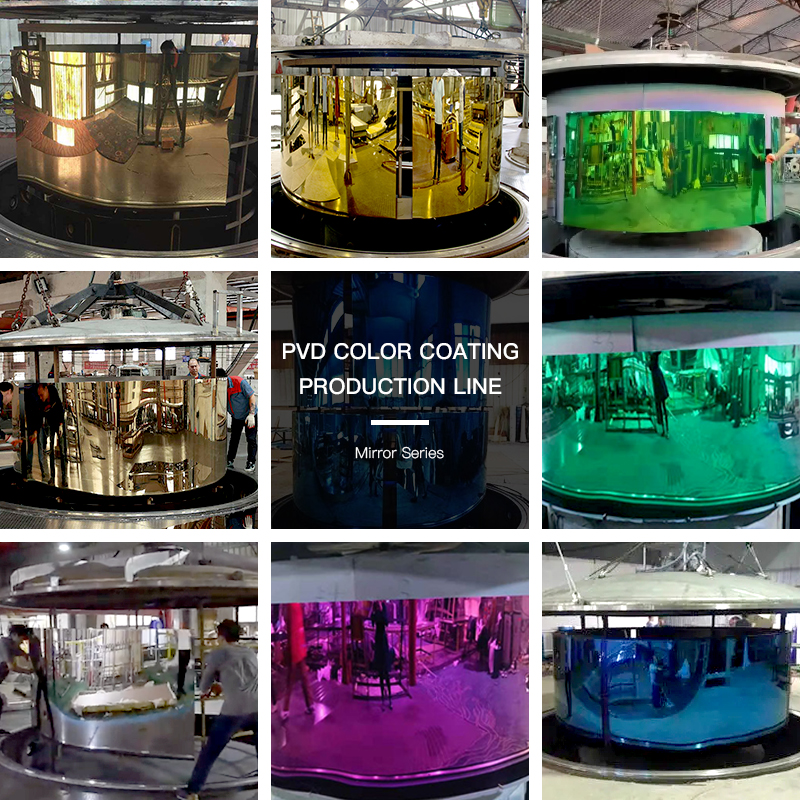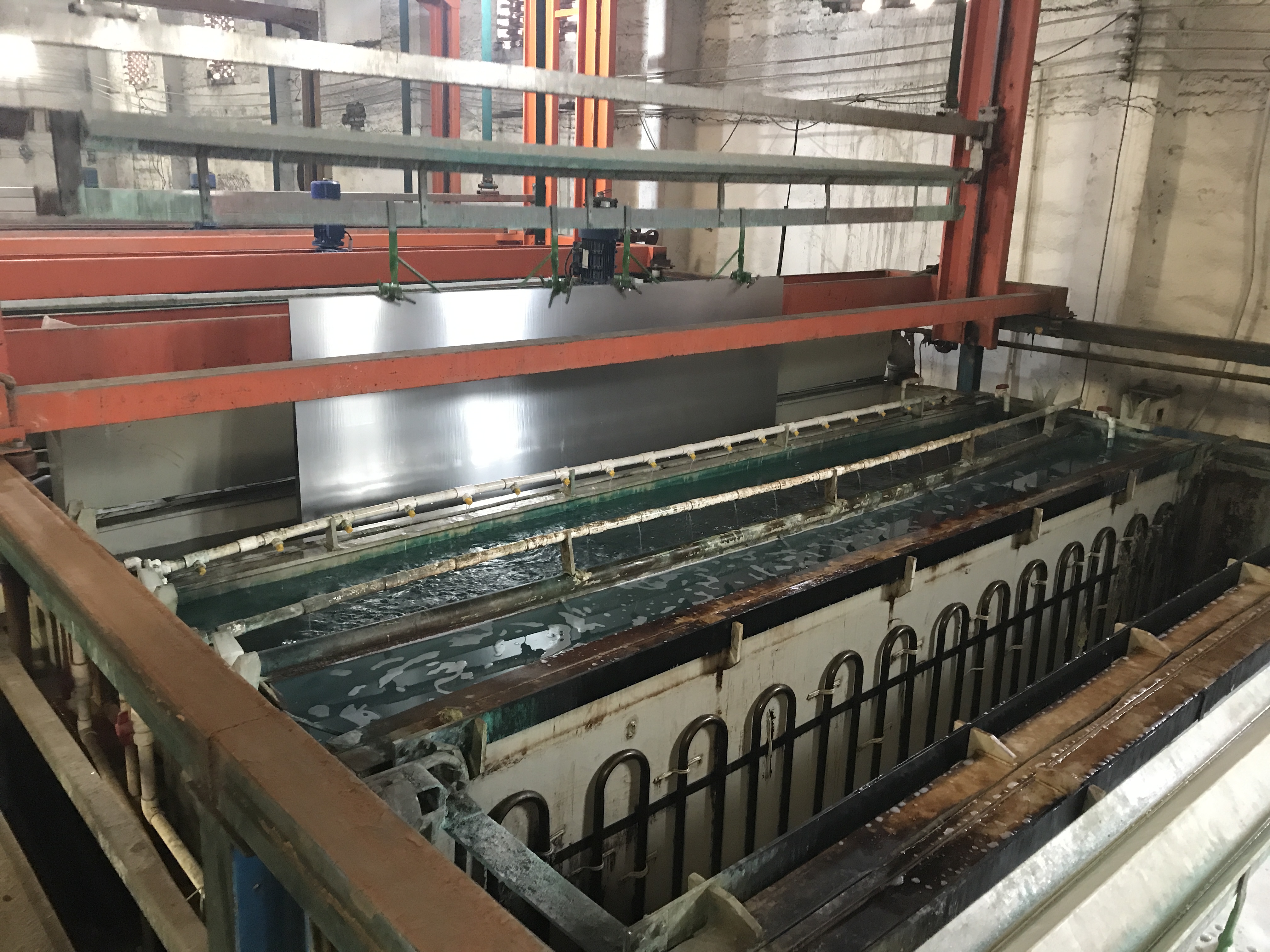With the development of the times, more and more people are choosing colored stainless steel as a decoration material, and this trend is becoming more and more obvious.So how is the stainless steel color plate plated?
Three commonly used color plating methods for stainless steel colored plates
1. Vacuum plating
Process: Color plating is performed in a vacuum environment at a specific temperature and time.
Features: Environmentally friendly, good metal texture, long-lasting and bright color
Conventional plating colors: black titanium (ordinary black), titanium gold, large gold, champagne gold, rose gold, yellow bronze, burgundy, brown, brown, sapphire blue, emerald green, 7 colors, etc.
Stainless steel color plate vacuum plating is a method of attaching a film or coating to the surface of stainless steel to change its color and appearance. This process typically involves placing a stainless steel plate in a vacuum chamber and then depositing a film or coating on the surface under vacuum conditions. Here are the general steps:
1. Prepare the stainless steel surface: First, the stainless steel surface needs to be prepared to ensure that the surface is clean and free of dirt, grease, or other impurities. This can be done through chemical cleaning or mechanical treatment.
2. Vacuum chamber setting: The stainless steel plate is placed in the vacuum chamber, which is a sealed environment that can control the internal pressure and atmosphere. There is usually a rotating table at the bottom of the vacuum chamber that rotates the stainless steel plate to ensure uniform deposition.
3. Heating: In a vacuum chamber, stainless steel plates may be heat treated to improve surface adhesion to films or coatings. Heating also helps with uniform deposition of the film.
4. Thin film deposition: Under vacuum conditions, the required thin film material (usually metal or other compounds) is evaporated or sprayed onto the stainless steel surface. This can be achieved by methods such as electron beam evaporation, magnetron sputtering, chemical vapor deposition, etc. Once the films are deposited, they form a uniform coating on the stainless steel surface.
5. Cooling and solidification: After the film is deposited, the stainless steel plate needs to be cooled and solidified in a vacuum chamber to ensure that the coating is firmly adhered to the surface. This process can be done inside a vacuum chamber.
6. Quality control: After completion of deposition and curing, quality control of the stainless steel colored plates is required to ensure that the color and appearance meet the requirements.
7. Packaging and Delivery: Once it passes quality control, the electroplated stainless steel color plates can be packaged and delivered to the customer or manufacturer for their final use.
Vacuum electroplating of stainless steel color plates can achieve various colors and effects, and is highly decorative and durable. This method is often used in areas such as high-end decoration, jewelry and watch manufacturing to change the appearance of stainless steel.
2. Water plating
Process: Color plating in specific solutions
Features: Not environmentally friendly enough, limited plating colors
Conventional plating colors: black titanium (blackened), bronze, red bronze, etc.
General steps for water plating of stainless steel colored plates:
Surface treatment: First, the surface of the stainless steel plate needs to be cleaned and treated to ensure that there is no grease, dirt or other impurities. This step is critical as it ensures uniformity and adhesion of the subsequent dyeing process.
Pretreatment: Before water plating, the stainless steel surface usually requires some special pretreatment to increase the adhesion of the pigment. This may include applying a layer of pre-treatment fluid to the surface to make it easier to absorb the pigment.
Water Plating: The main step of water plating involves applying a dyeing liquid (usually water-based) containing pigments and chemicals to the stainless steel surface. This dyeing liquid may contain a specific color dye, an oxidizing agent, and possibly a diluent. When the dyeing liquid comes into contact with the stainless steel surface, a chemical reaction occurs, causing the color to adhere to the surface.
Curing and drying: Dyed stainless steel panels usually need to be cured and dried under appropriate conditions to ensure that the color is firm and durable. This may involve steps such as heating or air drying.
Quality control: After completion of dyeing and drying, quality control of stainless steel color plates is required. This includes checking for color uniformity, adhesion, durability and possible defects.
Packaging and Delivery: Once it passes quality control, the dyed stainless steel color plates can be packaged and delivered to the customer or manufacturer for their end use.
3. Nano color oil
Process: The surface is colored with nano-color oil, similar to surface spraying
Features: 1) Almost any color can be electroplated
2) Colorant that can be made from real copper
3) There is no fingerprint protection after the color oil comes with it
4) The metal texture is slightly worse
5) Surface texture is covered to a certain extent
Conventional plating colors: Almost any color can be plated
Stainless steel color plate nano color oil is a color coating prepared using nanotechnology, which is usually applied to the surface of stainless steel to achieve a colorful appearance. This method exploits the scattering and interference effects of nanoparticles on light to produce a variety of colors and effects. Here are the general preparation steps:
1. Surface treatment: The stainless steel surface first needs to be cleaned and prepared to ensure that the surface is clean and free of grease, dirt or other impurities. This is an important step to ensure coating adhesion.
2. Primer coating: Before nano color oil coating, it is usually necessary to apply a layer of primer or primer on the stainless steel surface to improve the adhesion of the color coating and ensure uniformity.
3. Nano color oil coating: Nano color oil coating is a special coating composed of nanoparticles. These particles will produce interference and scattering effects under light irradiation, thus forming different color appearances. The size and arrangement of these particles can be adjusted to achieve the desired color effect.
4. Curing and drying: After applying the nano color oil coating, the stainless steel plate usually needs to be cured and dried under appropriate conditions to ensure that the color coating is firmly attached to the surface.
5. Quality control: After completion of coating and drying, quality control of stainless steel color plates is required to ensure color uniformity, adhesion and durability.
6. Packaging and Delivery: Once it passes quality control, the colored stainless steel plates can be packaged and delivered to the customer or manufacturer for their final use.
Nano color oil technology allows for colorful looks without the use of traditional pigments and is therefore very popular in decoration, design and high-end products. This method is commonly used in areas such as jewelry, watches, architectural decoration, and high-end electronic products.
Conclusion
Stainless steel colored plates with so many potential applications. Contact Hermes Steel today to learn more about our products, and services or get free samples. We would be happy to help you find the perfect solution for your needs. Please feel free to CONTACT US
Post time: Sep-14-2023



